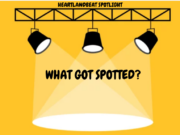July 12, 2012 – 9:30 a.m. – Herbicide Resistant Weed Management Field Day, David City
July 23, 2012 – 7:00 p.m. – Extension Board Meeting, Extension Office, YorkCropping UpdateIt was a nice surprise to see .60†of rain in my gauge Monday morning!  Other reports in the area were .30†around the area and .95†in the Bradshaw area near the York County Corn Grower plot!  I’m sure ready for a one or two day soaker across Nebraska!  It does not look like many chance for rain for the next few days, but only time will tell. The ETgages that I’ve been monitoring dropped between 1.80″ to 2.00†for the week.  The crop coefficient for most of the corn in our area is now 1.1, so we multiply 1.9 times 1.1 for a total crop ET of 2.09†or about .30â€/day!  Hopefully we’ve seen the last of the triple digit temperatures for the year!I received an email from Tamara Jackson, Extension Plant Pathologies that they’ve received confirmation from a colleague in the Pioneer lab in Iowa and Kevin Korus in our UNL Plant & Pest Diagnostic Clinic, that confirmed southern rust in 2 samples from Fillmore County. Both came from irrigated fields and the incidence and severity were low, but this is certainly something we will need to be on the lookout for.Tamara indicates that “Southern rust is an aggressive pathogen and can spread and worsen very quickly at optimal temperatures and with humidity and moisture to support infection. The warm night temperatures and high humidity likely are to blame, as well as the outbreak of the disease in southern states from which our spores probably originated.  In addition, we have had recent development of common rust, which is much less damaging and concerning, but may create some confusion when making diagnoses in the field. While the color of the spores/pustules can be different, this is really an unreliable and difficult characteristic to use to differentiate the diseases. Southern rust (tan to orange color) tends to sporulate predominately on the UPPER leaf surface, and common rust (red to brown) sporulates equally well on BOTH leaf surfaces.â€She indicated that the most reliable way to tell them apart is in the laboratory with microscopic examination of the spores, which Kevin is able to do quickly, so she recommend submitting samples to the UNL P&PDC for identification.She has also submitted an article along with several other timely cropping updates that will be posted on the CropWatch website: http://cropwatch.unl.edu, so check it out!  Also check out our NebGuide “Rust Disease of Corn in Nebraska†on the web at: http://www.ianrpubs.unl.edu/epublic/live/g1680/build/g1680.pdf.
So, now’s the time to be scouting those fields for gray leafspot as well as rust diseases and making decisions based on current recommendations.  Check out the Gray leafspot NebGuide at:  http://www.ianrpubs.unl.edu/epublic/live/g1902/build/g1902.pdf.
Limiting the development and Spread of Herbicide-Resistant Weeds Field Day
Just a reminder to mark July 12, 2012 on your calendar for this Field Day!  It will be held in the David City area.  The program will begin with registration at 9 a.m., a welcome, and tours beginning at 9:30 a.m. The keynote speaker will be during the noon hour, with the program expected to end by 1:30 p.m.  The event is free but preregistration is required by July 6 so plans can be made for the complimentary meal, teaching resources, and tour logistics. Register online at http://agronomy.unl.edu/weedresistmgt
Directions to the David City location:Â From Hwy 15 in David City, turn west on East A St., then continue west for 2 blocks and look for the UNL field signs.
Yard & Garden
The ETgage in front of our office with a #30 grass cover dropped 1.65″ this past week, but we received .60, so we needed just over an inch of rain this week!
I received two emails over the weekend from our Turf group.  The first was that as a result of the extended heat, humidity and drought conditions several turf diseases are beginning to show up in cool-season grasses because of the failing grass health and weather conditions favoring disease development.  Diseases showing up include Rust, Summer patch, Dollar spot and Brown patch.The seconded email was about the soil temperatures which as we’d expect were up at the Mead research station.  On July 3rd,  temperatures at the 4 inch depth were up 10 degrees F compared the 25 year average and growing degree days accumulation were double of the normal 25 year average.  No wonder it seems like we’ve mowed a lot more than normal?  As I mentioned last week, it’s more important than ever to raise that mower height and keep that mower blade sharp!
Finally, have you had problems with grubs in our turf in the past?  The adult beetles of masked chafer have been showing up the past couple of weeks, so if you’ve had problems with them in the past, preventative applications for white grubs should be applied in the next few weeks if you have not applied yet.
Check out the latest turf tips at: http://turf.unl.edu/.
































